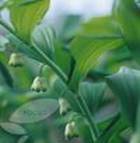| Kingdom | Plantae |
| unranked | Angiosperms |
| unranked | Monocots |
| Order | Asparagales |
| Family | Ruscaceae |
| Genus | Polygonatum |
| Species | P. multiflorum |
| Binomial name | Polygonatum multiflorum |
Other Common Names:
The other common names for the shrub Solomon's seal are Lady's Seals, St. Mary's Seal and Sigillum Sanctae Mariae.
History

Dr. Prior tells us it comes from 'the flat, round scars on the rootstocks, resembling the impressions of a seal and called Solomon's, because his seal occurs in Oriental tales.'
Description
A very hardy shade loving plant with gracefully arching stems with pendant white and green tipped bell shaped flowers. Solomon's seal, this plant features emerald-green leaves arranged alternately along tough, yet dainty looking arching stems. The waxy, cylindrical flowers hang in loose racemes from one side of the stem. Pendant white flowers appear in spring.



Range
Solomon's seal is widely distributed in Europe, including Britain, from Scandanavia south and east to Spain, and temperate Asia to Japan. Solomon's seal is quite rare in the wild.
Habitat
Solomon's seal prefers a cool position in a shady spot and looks wonderful in a woodland setting among shade-loving ferns.Polygonatum do not like dry soil. It thrives best in fertile, humus-rich, moist and well-drained soil.
Cultivation
Solomon's seal grows at its best in established clumps under large trees, preferring semi shade to full shade, where the clean soft green foliage and white flowers produce a delightfully cool effect. These plants are not suited to container growing due to their need for a cool root run. The soil can be either side of a neutral ph without ill effect but should be high in organic matter. Plant the rhizomes 8 to 12 cm under the soil surface and space them 30 to 50cm apart. Provide ample moisture during spring and summer for young plants, however once established they can tolerate some drying in late summer. In organic rich soils, no fertilizer is needed. Seed are best sown as soon as it is ripe in early autumn in a shady part of a cold greenhouse. Sow stored seed as early in the year as possible. Germination can be slow, they may not come true to type and it takes a few years for them to reach a good size. When they are large enough to handle, prick the seedlings out into individual pots and grow them on in a shady position in the greenhouse for at least their first winter. Plant them out into their permanent positions in late spring or early summer, after the last expected frosts. Division in March or October. Larger divisions can be planted out direct into their permanent positions. We have found that it is better to pot up the smaller divisions and grow them on in light shade in a cold frame until they are well established before planting them out in late spring or early summer.
Flowering Season
The hardy shade loving plant with white and green tipped bell shaped flowers which are in bloom in summer.
Pests and Diseases
These plants have no specific pest or disease issues. However occasionally they are affected by aphids and powdery mildew.
Parts Used

The rhizome is the most commonly used parts of the plant for its commercial and medicinal purposes.
Medicinal Applications


• It is used with other herbs in the treatment of pulmonary problems, including tuberculosis, and women's complaints.
• It is a traditional remedy for broken bones and, especially, for bruises.
• This plant is believed to prevent excess bruising and to stimulate tissue repair.
• It is applicable to problems affecting the respiratory system sore throats, dry and irritable coughs, bronchial congestion, and chest pain.
• It is good in the treatment of stomach inflammations, chronic dysentery etc.
• The dried powdered roots and flowers have been used as a snuff to promote sneezing and thus clear the bronchial passages.
• It is used mainly as a poultice which helps the application of the plant's astringent and demulcent properties to speed healing.
• Solomon's seal has also been recommended as a treatment for tuberculosis, as a remedy for menstrual problems, and as a tonic.
• The root acts as an astringent, demulcent, emetic and tonic.
Commercial Applications


• A distilled water made from the whole plant is used as a cosmetic to improve the complexion.
• Solomon's seal contains saponin and is also used in the soap industry.
• The roots macerated for some time in water yield a substance capable of being used as food and consisting principally of starch.
• The young shoots form an excellent vegetable when boiled and eaten like Asparagus, and are largely consumed in Turkey.
• The roots of another species have been made into bread in times of scarcity, but they require boiling or baking before use.

The round depressions, or the characters which appear when the root is cut transversely, and which somewhat resemble Hebrew characters, gave rise to the notion that Solomon 'who knew the diversities of plants and the virtues of roots,' has set his seal upon them in testimony of its value to man as a medicinal root. Gerard maintained that the name Sigillum Solomon's was given to the root partly because it bears marks something like the stamp of a seal, but still more because of the virtue the root hath in sealing and healing up green wounds, broken bones and such like, being stamped and laid thereon. The name Lady's Seal was also conferred on the plant by old writers, as also St. Mary's Seal.